By: Antonio Vivaldi
Week: 1
Cool, crisp days and brightly colored leaves characterize autumn in northern climates. The next four weeks focus on selections that embody the fall season. Go outside, play in the leaves, and enjoy the music. Antonio Vivaldi wrote 'The Four Seasons' in 1723. The four concertos celebrate the seasons of spring, summer, autumn, and winter. Vivaldi published sonnets to accompany each season's concerto. He may have written these poems himself. The fall piece varies from brisk to slow and back to brisk, like a calm day between windy days.
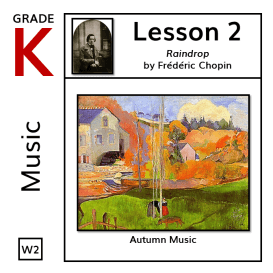
By: Frédéric Chopin
Week: 2
Cool, crisp days and brightly colored leaves characterize autumn in northern climates. This week features another selection that embodies the fall season. Go outside, play in the leaves, and enjoy the music. Written between 1835 and 1839, Frédéric Chopin's 24 Preludes, Op. 28 are a set of short piano compositions. Preludes are short musical pieces that often introduce more complex pieces. The wistful nature of the opening and closing notes of No. 15 'Raindrop' is reminiscent of the last rains of fall before the winter snow arrives to cocoon the memories of summer.
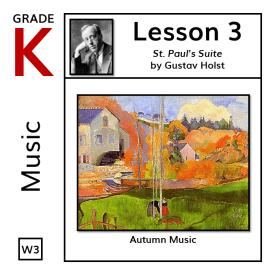
By: Gustav Holst
Week: 3
Cool, crisp days and brightly colored leaves characterize autumn in northern climates. This week features another selection that embodies the fall season. Go outside, play in the leaves, and enjoy the music. St. Paul's Suite, a composition for string orchestra, was written in 1912 when Gustav Holst was the director of music at St Paul's Girls' School in London, England. It has four movements: 1) Jig - Vivace (lively and brisk manner), 2) Ostinato - Presto (a quick tempo), 3) Intermezzo - Andante con moto (moderately slow), and 4) Finale - Allegro (brisk tempo). This piece evokes the crisp, colorful days during the fall semester of a school year.
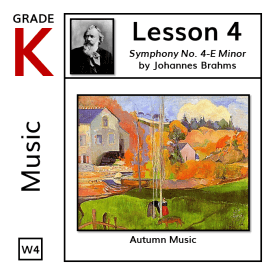
By: Johannes Brahms
Week: 4
Cool, crisp days and brightly colored leaves characterize autumn in northern climates. This week features another selection that embodies the fall season. Go outside, play in the leaves, and enjoy the music. Written by the composer Johannes Brahms in 1884, 'Symphony No. 4' kindles recollections of shortening days, cooling air, animals busy preparing for winter, and falling leaves. This piece has four movements: 1) Allegro non troppo (fast, but not too fast), 2) Andante moderato (moderately slow, comfortable and easy), 3) Allegro giocoso (quick and playful), and 4) Allegro energico e passionato (fast with energy and passion).
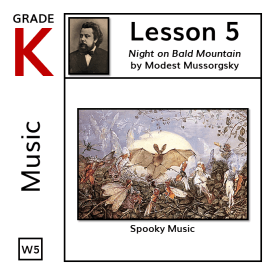
By: Modest Mussorgsky
Week: 5
Pumpkin picking, leaves crunching underfoot, corn mazes, hay rides, and apple cider, the fall is a season for family fun. The next four weeks focus on spooky selections that embody the spirit of the season. Get a flashlight, hide under a blanket, and read some spine-tingling stories while listening to the spooky music. Written in 1867 in only 12 days, 'Night on Bald Mountain' is a symphonic poem. Composers write symphonic poems to accompany stories, paintings, or (non-musical) poems. Modest Mussorgsky wrote this spooky music about witches gathering on a mountain. This piece was never played by an orchestra during Mussorgsky's lifetime. Another composer rewrote the piece after Mussorgsky’s death, and only then was it finally played.
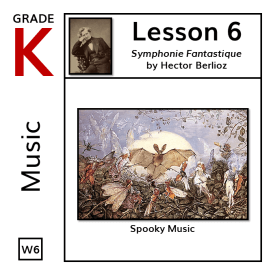
By: Hector Berlioz
Week: 6
Pumpkin picking, leaves crunching underfoot, corn mazes, hay rides, and apple cider, the fall is a season for family fun. This week features another spooky selection. Get a flashlight, hide under a blanket, and read some spine-tingling stories while listening to the spooky music. Hector Berlioz wrote the otherworldly 'Symphonie Fantastique' in 1830. The sheet music includes over 90 instruments. The included recording is the fifth movement of 'Symphonie Fantastique' entitled, 'Dream of the Night of the Sabbath.' 'Symphonie Fantastique' is about a gathering of spooky creatures who dance and frolic.
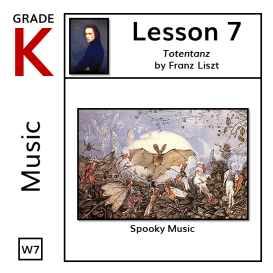
By: Franz Liszt
Week: 7
Pumpkin picking, leaves crunching underfoot, corn mazes, hay rides, and apple cider, the fall is a season for family fun. This week features another spooky selection. Get a flashlight, hide under a blanket, and read some spine-tingling stories while listening to the spooky music. Hungarian composer Franz Liszt was fascinated by the concepts of religion, heaven, life, and death. A haunting reflection of human mortality, 'Totentanz' reflects Liszt's keen interest. Totentanz means 'Dance of the Dead' in English.
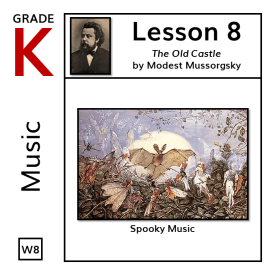
By: Modest Mussorgsky
Week: 8
Pumpkin picking, leaves crunching underfoot, corn mazes, hay rides, and apple cider, the fall is a season for family fun. This week features another spooky selection. Get a flashlight, hide under a blanket, and read some spine-tingling stories while listening to the spooky music. Modest Mussorgsky wrote 'Pictures at an Exhibition' in memory of his friend, Viktor Hartmann, who died young at the age of 39. Each movement within the suite represents one of Hartmann's pictures. 'The Old Castle' was inspired by Hartmann's sketch of an Italian castle.
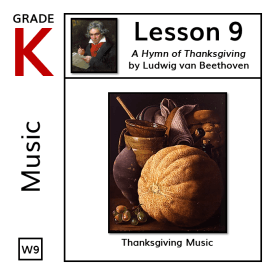
By: Ludwig van Beethoven
Week: 9
Pumpkin pie, stuffing, green bean casserole, family gatherings, and giving thanks for our blessings, November is a month to appreciate our homes and families and to reflect on all that we have. For the next four weeks, you'll listen to selections that embody gratefulness for home, health, family, and country. Enjoy this music while preparing your Thanksgiving dinner or eating your Thanksgiving meal. Ludwig van Beethoven composed string quartet, Opus 132 in A minor near the end of his life. He was 54 and recovering from a life-threatening illness which he cured by limiting his diet to certain foods. In Beethoven's words, this movement was 'offered to the divinity by a convalescent.' Beethoven said the more energetic parts of the piece reflected him 'feeling new strength.'
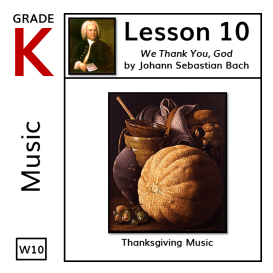
By: Johann Sebastian Bach
Week: 10
Pumpkin pie, stuffing, green bean casserole, family gatherings, and giving thanks for our blessings, November is a month to appreciate our homes and families and to reflect on all that we have. This week, continue to listen to selections that embody gratefulness for home, health, family, and country. Johann Sebastian Bach wrote cantata 'We thank you, God, we thank you' in 1731. A cantata is 'a medium-length narrative piece of music for voices with instrumental accompaniment, typically with solos, chorus, and orchestra.'
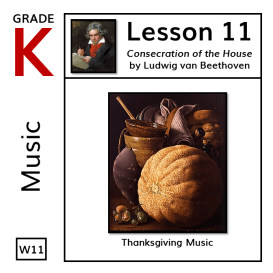
By: Ludwig van Beethoven
Week: 11
Pumpkin pie, stuffing, green bean casserole, family gatherings, and giving thanks for our blessings, November is a month to appreciate our homes and families and to reflect on all that we have. This week, continue to listen to selections that embody gratefulness for home, health, family, and country. Ludwig van Beethoven composed 'The Consecration of the House, Op. 124' in 1822 for the opening of the Josephstadt Theater in Vienna, Austria. A 'consecration' is the dedication of something for a certain purpose. A theater might be consecrated to promote the arts and elevate the human spirit. People might consecrate their own houses as well, dedicating their houses to their families and the love they share in them.
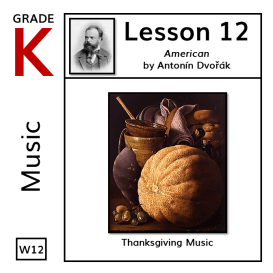
By: Antonín Dvořák
Week: 12
Pumpkin pie, stuffing, green bean casserole, family gatherings, and giving thanks for our blessings, November is a month to appreciate our homes and families and to reflect on all that we have. This week, listen to the final selection that embodies gratefulness for home, health, family, and country. Inspired by a visit to America, Antonín Dvořák created 'String Quartet no. 12 in F major 'American,' Op. 96' based on American landscapes. It reminds us to be thankful for our homelands and the beautiful world we live in.
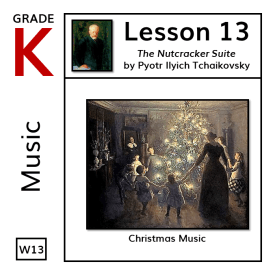
By: Pyotr Ilyich Tchaikovsky
Week: 13
Giving to others, family gatherings, religious worship, trimming trees, special songs, eggnog, and mistletoe, the Christmas holiday involves comforting traditions for many. For the next four weeks, you'll listen to selections associated with the Christmas season. For those who celebrate Christmas, enjoy this music while baking Christmas cookies, hanging stockings, decorating your tree, or opening presents. The Nutcracker Suite, Op. 71a is a ballet written by Pyotr Ilyich Tchaikovsky in 1892. It is performed by ballet companies across the United States during the Christmas season. A ballet is a dance that is performed to music and tells a story. The story of the Nutcracker ballet is based on E.T.A. Hoffmann's story 'The Nutcracker and the Mouse King.' In the story, a girl named Maria (name typically Clara in the ballet version) receives a Nutcracker from her uncle on Christmas Eve. That night, the Nutcracker is transformed into a handsome prince. With the help of Maria, the prince defeats the Mouse King and his army of mice. Maria and the prince travel to the Land of Sweets and see magical dances and wondrous people and places.
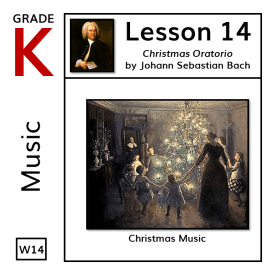
By: Johann Sebastian Bach
Week: 14
This week, you'll continue listening to selections that embody the Christmas season. For those who celebrate Christmas, enjoy this music while baking Christmas cookies, hanging stockings, decorating your tree, or opening presents. J.S. Bach wrote his 'Christmas Oratorio' in 1734 to be performed in Christian churches during the Christmas season. An oratorio is defined as: 'a large-scale musical work for orchestra and voices, typically a narrative on a religious theme, performed without the use of costumes, scenery, or action' (Google define). 'Christmas Oratorio' contains six cantatas. From the Wikipedia entry on 'Christmas Oratorio': 'The first part (for Christmas Day) describes the birth of the Christian figure Jesus Christ, the second (for December 26) the annunciation to the shepherds, the third (for December 27) the adoration of the shepherds, the fourth (for New Year's Day) the naming of Jesus, the fifth (for the first Sunday after New Year) the journey of the Magi, and the sixth (for Epiphany) the adoration of the Magi.
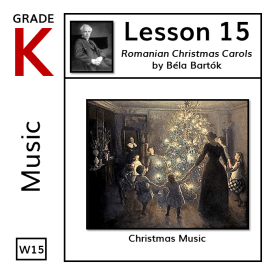
By: Béla Bartók
Week: 15
This week, you'll continue listening to selections that embody the Christmas season. For those who celebrate Christmas, enjoy this music while baking Christmas cookies, hanging stockings, decorating your tree, or opening presents. Adapted in in 1915, Béla Bartók based his 'Romanian Christmas Carols, Sz. 57' on carols traditionally sung by Romanian village children. The work contains twenty Christmas Carols, played continuously without a break.
Week: 16
This week, you'll continue listening to selections that embody the Christmas season. For those who celebrate Christmas, enjoy this music while baking Christmas cookies, hanging stockings, decorating your tree, or opening presents. Deck the Halls is a traditional Christmas carol. The song implores listeners to decorate, to sing, and to spread good cheer for the Christmas season. This piece is an arrangement for brass instruments. Brass instruments include the trumpet and the trombone and are often made of brass.
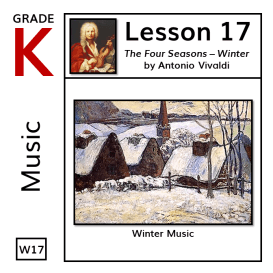
By: Antonio Vivaldi
Week: 17
Bundling up under the covers, making snowmen and snow angels, sledding over the snow, and icicles dangling from gutters, For the next four weeks, you'll listen to selections that embody the winter season. If you live in an area that becomes cold and snowy, play this music, enjoy some hot cocoa, and watch the snow fall. Antonio Vivaldi wrote 'The Four Seasons' in 1723. The four concertos celebrate the seasons of spring, summer, autumn, and winter. Vivaldi published sonnets to accompany each season's concerto. He may have written these poems himself. The winter concerto varies its tempo and tone to reflect the vagaries of winter weather, from snowflakes drifting down from the sky to the wind whipping up violent snowstorms.
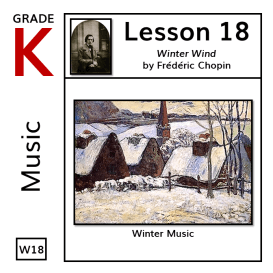
By: Frédéric Chopin
Week: 18
Bundling up under the covers, making snowmen and snow angels, sledding over the snow, and icicles dangling from gutters, you'll continue to listen to selections that embody the winter season. If you live in a snowy area, play this music, enjoy some hot cocoa, and watch the snow drift down from the sky. Frédéric Chopin composed 'Etude Op. 25 no. 11 in A minor - Winter Wind' in 1836. An 'etude' is defined as: 'a short musical composition, typically for one instrument, designed as an exercise to improve the technique or demonstrate the skill of the player' (Google define). 'Winter Wind' reflects the frigid winds and swirling snowflakes of the winter season.
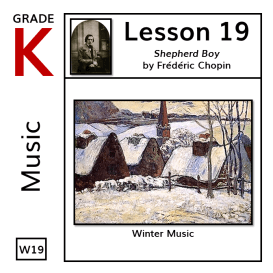
By: Frédéric Chopin
Week: 19
Bundling up under the covers, making snowmen and snow angels, sledding over the snow, and icicles dangling from gutters, you'll continue to listen to selections that embody the winter season. If you live in a snowy area, play this music, enjoy some hot cocoa, and watch the snow drift down from the sky. Frédéric Chopin composed 'Aeolian Harp' or 'Shepherd Boy' in 1836. An Aeolian Harp is an instrument made of a box and strings that is played by the wind. People place Aeolian Harps in open windows to let the wind play the music. This piece is also called 'Shepherd' boy because Chopin reportedly advised his students to picture a poor shepherd boy taking refuge from a cold storm as they played the piece.
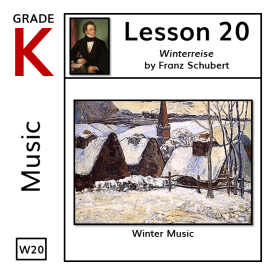
By: Franz Schubert
Week: 20
Bundling up under the covers, making snowmen and snow angels, sledding over the snow, and icicles dangling from gutters, you'll listen to the final selection that embodies the winter season. If you live in a snowy area, play this music, enjoy some hot cocoa, and watch the snow drift down from the sky. Franz Schubert composed Winterreise, Der Leiermann (Winter Journey, The Organ Grinder) in 1827 based on the poem 'Der Leiermann' (The Organ Grinder or The Hurdy-Gurdy Man) by Wilhelm Müller. See in the enrichment activities section a translation of the poem by Celia Sgroi.
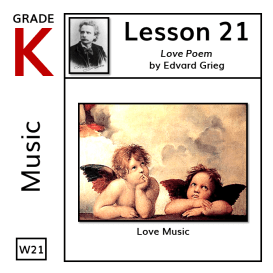
By: Edvard Grieg
Week: 21
Showing kindness and appreciation, planning happy surprises, and thinking of those you love, for the next four weeks, in honor of the Valentine's season, you'll listen to selections that represent love and affection for family and friends. Norwegian composer and pianist Edvard Grieg wrote 66 short compositions for 'Lyric Pieces.' They were published between 1867 and 1901. They are often referred to as 'mood pieces,' written to evoke certain feelings in the listener. Grieg may have written 'Love Poem' as a declaration of love for his wife, Nina.
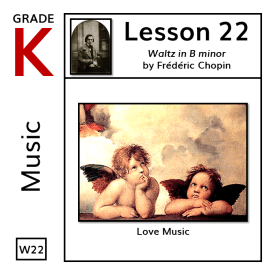
By: Frédéric Chopin
Week: 22
Showing kindness and appreciation, planning happy surprises, and thinking of those you love, in honor of the Valentine's season, you'll continue to listen to selections that represent love and affection for family and friends. Frédéric Chopin wrote 'Waltz in B minor, Op. 69 no. 2' in 1829 for solo piano. It was not published until after his death. Chopin reportedly wanted this composition burned after he died (and his other unpublished works at the time of his death). This composition is one of Chopin's easier to perform and better-known works. The name 'waltz' originally comes from a word that refers to the turning movement associated with the waltz dance. This lovely piece conjures images of dancing couples gracefully twirling around a ballroom floor.
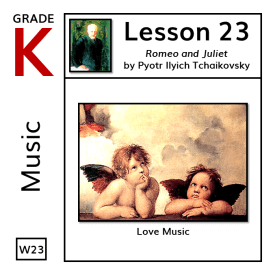
By: Pyotr Ilyich Tchaikovsky
Week: 23
Showing kindness and appreciation, planning happy surprises, and thinking of those you love, in honor of the Valentine's season, you'll continue to listen to selections that represent love and affection for family and friends. Pyotr Tchaikovsky based 'Romeo and Juliet (Overture-Fantasia)' on the Shakespeare's play of the same name. His initial version was not a success with the audience, but he persisted, rewriting the work. The revised work was published in 1870. There are three parts - the first part is foreboding of the tragedy to come, the second part is warlike with symbols crashing and symbolizes the fight between the families of Romeo and Juliet, and the third and most famous part emotes the love between Romeo and Juliet.
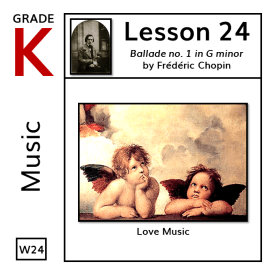
By: Frédéric Chopin
Week: 24
Showing kindness and appreciation, planning happy surprises, and thinking of those you love, in honor of the Valentine's season, you'll listen to the last selection that represents love and affection for family and friends. Frédéric Chopin composed 'Ballade no. 1 in G minor, Op. 23' in 1831. At the time, he lived in Vienna and longed for his home in Poland, where the people were fighting against the Russian Empire. He incorporated his feelings of longing, loyalty, and love for his homeland into this piece (Wikipedia entry on the piece).
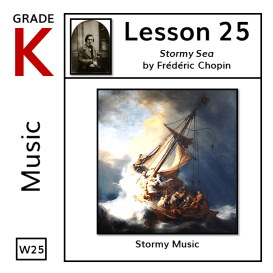
By: Frédéric Chopin
Week: 25
Transitioning from winter to spring, uncertain and unstable weather, and feeling invigorated and hopeful, For the next four weeks, you'll listen to selections that embody the turbulence of the transition from winter to spring. Listen to this music from the warmth and comfort of your home as the cold wind blows ice, snow, and/or rain all around you. Written between 1835 and 1839, Chopin's '24 Preludes, Op. 28' are a set of short piano compositions. Preludes are short pieces of music that often serve as introductions to more complex pieces. This piece captures the turbulence of a stormy sea.
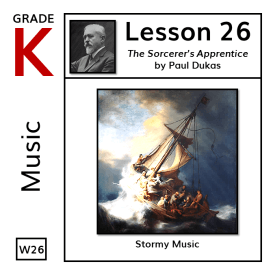
By: Paul Dukas
Week: 26
Transitioning from winter to spring, uncertain and unstable weather, and feeling invigorated and hopeful, you'll continue listen to selections that embody the turbulence of the transition from winter to spring. Listen to this music from the warmth and comfort of your home as the cold wind blows ice, snow, and rain all around you. Written between 1896 and 1897, 'The Sorcerer's Apprentice' is a symphonic poem by the French composer Paul Dukas. Johann Wolfgang von Goethe's 1797 poem of the same name inspired this piece. In the poem, a sorcerer has left his apprentice and has tasked him to clean. The apprentice enchants a broomstick to do the cleaning for him, and the situation soon spirals out of control. Both the music and the storyline from the poem were featured in Disney's cartoon 'Fantasia.'
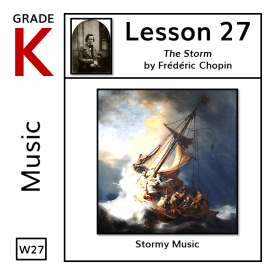
By: Frédéric Chopin
Week: 27
Transitioning from winter to spring, uncertain and unstable weather, and feeling invigorated and hopeful, you'll continue listen to selections that embody the turbulence of the transition from winter to spring. Listen to this music from the warmth and comfort of your home as the cold wind blows ice, snow, and rain all around you. Written between 1835 and 1839, Frédéric Chopin's '24 Preludes, Op. 28' are a set of short compositions for the piano. This work captures the tempestuous nature of a storm.
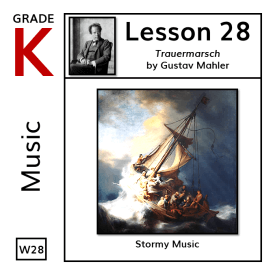
By: Gustav Mahler
Week: 28
Transitioning from winter to spring, uncertain and unstable weather, and feeling invigorated and hopeful, you'll continue listen to selections that embody the turbulence of the transition from winter to spring. Listen to this music from the warmth and comfort of your home as the cold wind blows ice, snow, and rain all around you. Mahler composed Symphony no. 5 from 1901 to 1902. Trauermarsch (Funeral March) reflects the tumultuous process of grieving a loved one.

By: Antonio Vivaldi
Week: 29
Birds singing, leaves budding, and baby animals frolicking, for the next four weeks, you'll listen to selections that embody the bloom of spring. Get outside or throw open some windows. Listen to this music and enjoy the renewing sunshine and refreshing breezes of spring. Vivaldi wrote 'The Four Seasons' in 1723. The four concertos celebrate the seasons of spring, summer, autumn, and winter. Vivaldi published sonnets to accompany each season's concerto. He may have written these poems himself. The spring piece is fresh and rejuvenating, like the renewal of life after a long winter of hibernation.
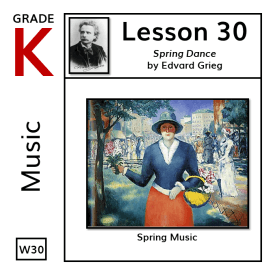
By: Edvard Grieg
Week: 30
Birds singing, leaves budding, and baby animals frolicking, you'll continue to listen to selections that embody the bloom of spring. Get outside or throw open some windows. Listen to this music and enjoy the renewing sunshine and refreshing breezes of spring. Norwegian composer and pianist Edvard Grieg wrote 66 short pieces for 'Lyric Pieces.' They were published between 1867 and 1901. 'Spring Dance' captures the joy and renewal of spring after a long, cold, and dark winter.
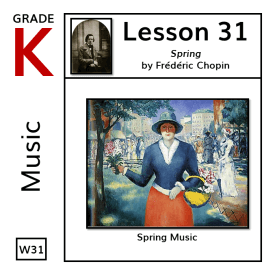
By: Frédéric Chopin
Week: 31
Birds singing, leaves budding, and baby animals frolicking, you'll continue to listen to selections that embody the bloom of spring. Get outside or throw open some windows. Listen to this music and enjoy the renewing sunshine and refreshing breezes of spring. Frédéric Chopin wrote 'Andantino Spring, B. 117' for piano around 1838. This composition is a little melancholy, reflecting that with change, even one from winter to spring, we may feel regret for what once was. Chopin based this piece on a Polish poem by his friend Stefen Witwicki.
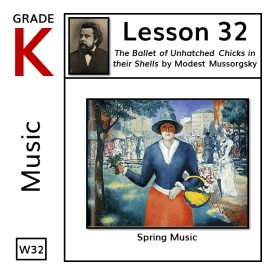
By: Modest Mussorgsky
Week: 32
Birds singing, leaves budding, and baby animals frolicking, you'll listen to the last selection that embodies the bloom of spring. Get outside or throw open some windows. Listen to this music and enjoy the renewing sunshine and refreshing breezes of spring. Modest Mussorgsky wrote 'Pictures at an Exhibition' in memory of his friend, Viktor Hartmann, who died young at the age of 39. Each movement within the suite represents one of Hartmann's pictures. This piece was inspired by Hartmann's painting, 'Ballet of the Unhatched Chicks,' of a child wearing a costume of a hatching chick.

By: Antonio Vivaldi
Week: 33
Spring swinging into summer, flowers thriving, and people basking in the sunshine, For the next four weeks, you'll listen to selections that embody the freedom of summer. Listen to this music as you enjoy playing outside on the green grass. Antonio Vivaldi wrote 'The Four Seasons' in 1723. The four concertos celebrate the seasons of spring, summer, autumn, and winter. Vivaldi published sonnets to accompany each season's concerto. He may have written these poems himself. This composition captures the lush splendor of summer.
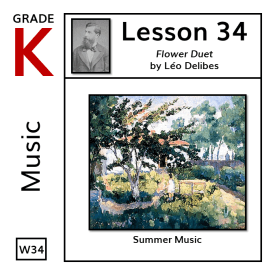
By: Léo Delibes
Week: 34
Spring swinging into summer, flowers thriving, and people basking in the sunshine, you'll continue to listen to selections that embody the freedom of summer. Listen to this music as you enjoy playing outside on the green grass. Léo Delibes' 'Flower Duet' is a famous duet from his opera Lakmé. The duet is sung by Lakmé, a princess, and Mallika, her handmaid, in a garden near a river. They celebrate how flowers uplift their souls, even in times of conflict.
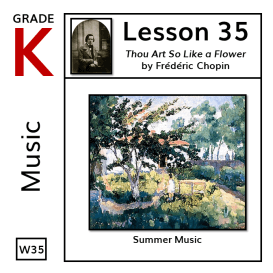
By: Frédéric Chopin
Week: 35
Spring swinging into summer, flowers thriving, and people basking in the sunshine, you'll continue to listen to selections that embody the freedom of summer. Listen to this music as you enjoy playing outside on the green grass. Written between 1835 and 1839, Frédéric Chopin's '24 Preludes, Op. 28' are a set of short compositions for the piano. Chopin dedicated 'Thou Art So Like a Flower' to Camille Pleyel, a pianist who owned the concert hall where Chopin played. This work is bright and sunny, like a flower gently waving in a field under a bright blue sky. Why might you compare something or someone to a flower? Flowers are beautiful, many smell nice, and just having them around can make people happy. Of course, whether this comparison is a compliment or an insult is dependent on the flower. Some flowers emit a smell like rotting meat to attract insects.
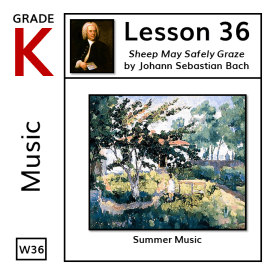
By: Johann Sebastian Bach
Week: 36
Spring swinging into summer, flowers thriving, and people basking in the sunshine, you'll listen to the final selection that embodies the freedom of summer. Listen to this music as you enjoy playing outside on the green grass. Composed in 1713, Johann Sebastian Bach's piece is known by multiple names - 'The lively hunt is all my heart's desire,' 'Sheep May Safely Graze,' 'Hunting Cantata,' and 'Birthday Cantata.' The first three come from the lyrics which accompany this piece. It is also called 'Birthday Cantata,' because it was commissioned for a birthday by a wealthy benefactor.